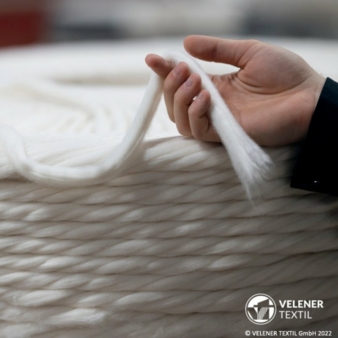08/09/2022 – 36th International Cotton Conference Bremen
Textile processes in the fast lane
There will be several lectures on problem areas and suitable solutions in the context of textile processes on September 30, 2022, at the 36th International Cotton Conference Bremen.
The Bremen Cotton Exchange and the Fibre Institute Bremen e.V. are inviting participants to the 36th International Cotton Conference Bremen on 29 and 30 September. Under the motto “Cotton Decoded”, all national and international conference participants will be offered an ambitious programme with up-to-date lectures and lively discussions, both on site in Bremen and via an online conference platform. Cotton testing methods, fibre quality and the effects of spinning processes on productivity have been at the heart of the Bremen event since 1965.
On Friday, 30 September, there will be several lectures on problem areas in the context of textile processes, which at the same will provide ideas for suitable solutions:
Precleaning of cotton
For Ralf Müller from the Trützschler SE group of companies, Mönchengladbach, the precleaning of cotton is a key issue in spinning mill preparation. For this, Trützschler has developed a new generation of pre-cleaner units. Intelligent cleaning can save up to 150 cotton bales per year if it ensures maximum raw material utilisation and results in minimum good fibre loss.
Targeted raw material management pays off
Oswald Baldischwieler represents the Swiss specialist for fibre quality inspection systems Uster Technologies, Uster. He explains how and why it is necessary to carry out an intensive examination of the cotton fibres at the time of bale mixing to achieve consistent quality of yarns and fabrics. Raw materials absorb most of the costs in spinning.
Spinning waste cotton
The Swiss Rieter AG, the world's leading supplier of systems for short-staple fibre spinning, is represented by Harald Schwippl: The recycling of raw materials has been a trend for several years. In the spinning mill, for example, card or blow room waste can be used for processing. Schwippl explains the necessary adjustments in the spinning process, as well as showing which spinning units and qualities are possible.
Shortening production processes
Yonathan Sissay from the Ethiopian Textile Industry Development Institute, Addis Ababa, reports on reducing lead times in clothing manufacturing processes through to packaging and delivery. In his study, necessary and superfluous work steps were analysed, and based on the Pareto principle, new process flow charts for efficient and economical working were defined.
Effect of the short fibre content on forces at drafting zone
As part of his research project, Pakistani scientist Quasim Siddiqui determined that the draft force is a dynamic factor that arises from different frictional forces between slow and fast-moving fibres in the draft zone of the spinning process. The fibre length is one of the most important factors. He studied the interaction between the dynamic stretching force and its variability with the short fibre content of the carded cotton sliver.
Expert meeting
On September 28, the day before the conference begins, there will be an exchange among experts under the headline ‘Quality requirements along the textile value chain’. The Fibre Institute Bremen (FIBRE), the Bremen Cotton Exchange, the Industry Association – Finishing – Yarns – Fabrics and Technical Textiles (IVGT) and the International Textiles Manufacturers Federation (ITMF) invite everyone to take part.
Registrations can be made at any time on the conference website.




